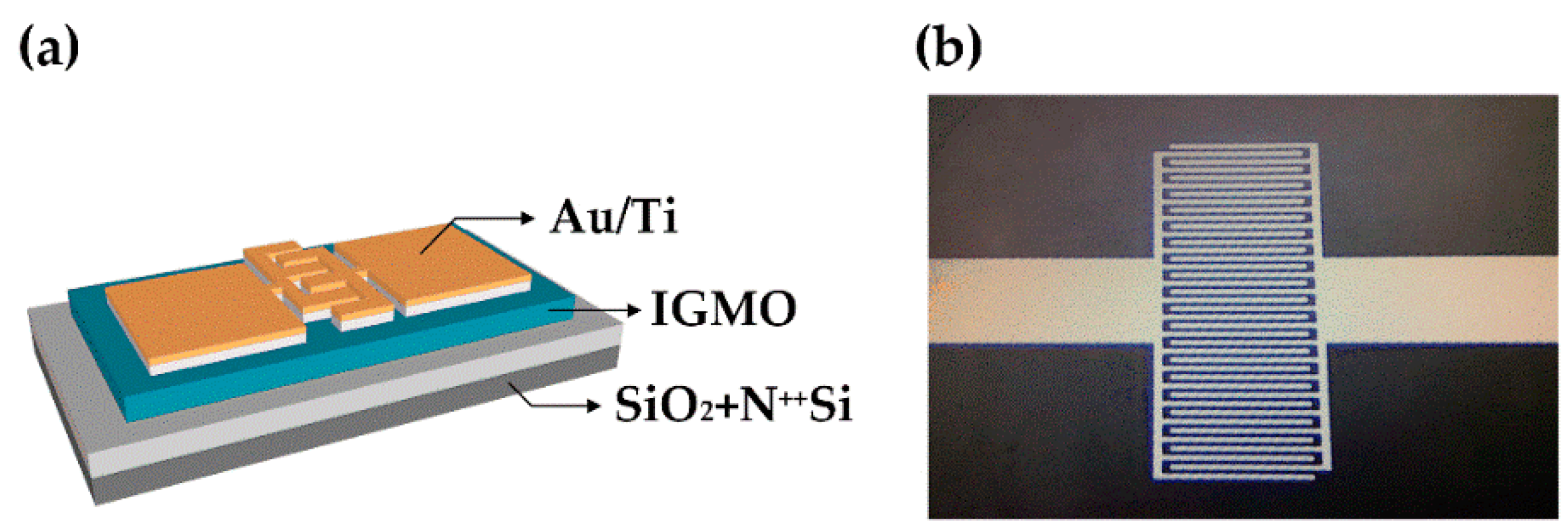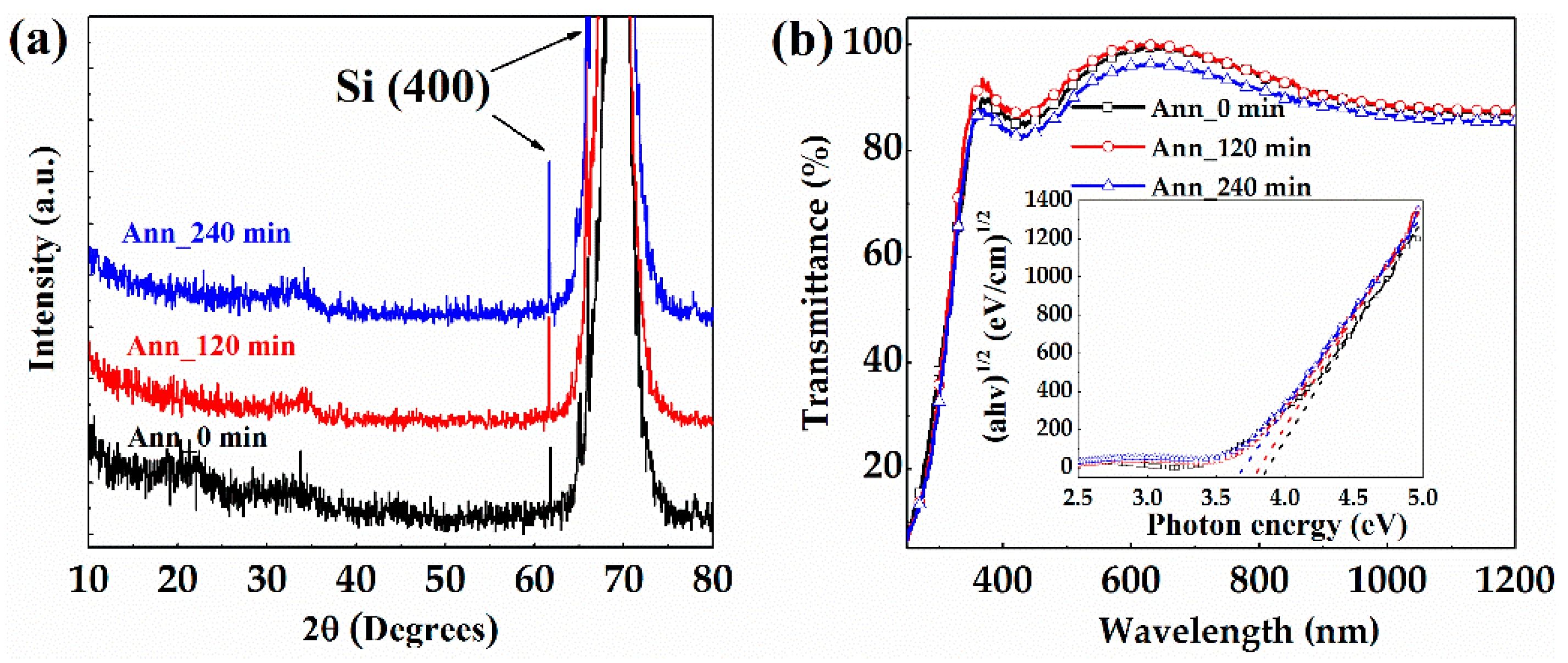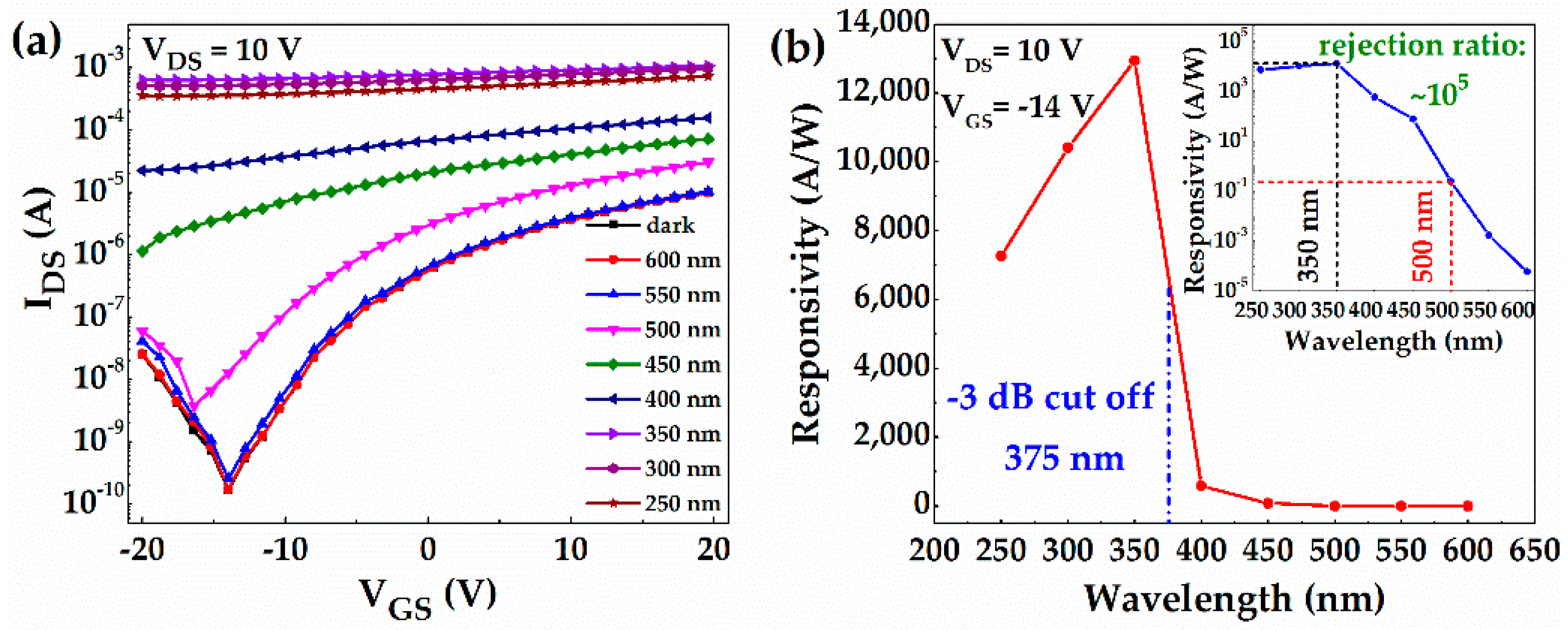Amorphous InGaMgO Ultraviolet Photo-TFT with Ultrahigh Photosensitivity and Extremely Large Responsivity
Abstract
:1. Introduction
2. Experimental Details
3. Results and Discussion
4. Conclusions
Acknowledgments
Author Contributions
Conflicts of Interest
References
- Kamiya, T.; Nomura, K.; Hosono, H. Present status of amorphous In-Ga-Zn-O thin-film transistors. Sci. Technol. Adv. Mater. 2010, 11, 044305. [Google Scholar] [CrossRef] [PubMed]
- Qian, L.X.; Lai, P.T.; Tang, W.M. Effects of Ta incorporation in La2O3 gate dielectric of InGaZnO thin-film transistor. Appl. Phys. Lett. 2014, 104, 123505. [Google Scholar] [CrossRef] [Green Version]
- Qian, L.X.; Lai, P.T. Fluorinated InGaZnO Thin-Film Transistor With HfLaO Gate Dielectric. IEEE Electron Device Lett. 2014, 35, 363–365. [Google Scholar] [CrossRef]
- Jeon, S.; Ahn, S.E.; Song, I.; Kim, C.J.; Chung, U.I.; Lee, E.; Yoo, I.; Nathan, A.; Lee, S.; Robertson, J.; et al. Gated three-terminal device architecture to eliminate persistent photoconductivity in oxide semiconductor photosensor arrays. Nat. Mater. 2012, 11, 301–305. [Google Scholar] [CrossRef] [PubMed]
- Fung, T.C.; Chuang, C.S.; Nomura, K.; Shieh, H.P.D.; Hosono, H.; Kanicki, J. Photofield-Effect in Amorphous In-Ga-Zn-O (a-IGZO) Thin-Film Transistors. J. Inf. Display 2008, 9, 21–29. [Google Scholar] [CrossRef]
- Zan, H.-W.; Chen, W.-T.; Hsueh, H.-W.; Kao, S.-C.; Ku, M.-C.; Tsai, C.-C.; Meng, H.-F. Amorphous indium-gallium-zinc-oxide visible-light phototransistor with a polymeric light absorption layer. Appl. Phys. Lett. 2010, 97, 203506. [Google Scholar] [CrossRef]
- Chang, T.H.; Chiu, C.J.; Weng, W.Y.; Chang, S.J.; Tsai, T.Y.; Huang, Z.D. High responsivity of amorphous indium gallium zinc oxide phototransistor with Ta2O5 gate dielectric. Appl. Phys. Lett. 2012, 101, 261112. [Google Scholar] [CrossRef]
- Pei, Z.; Lai, H.-C.; Wang, J.-Y.; Chiang, W.-H.; Chen, C.-H. High-Responsivity and High-Sensitivity Graphene Dots/a-IGZO Thin-Film Phototransistor. IEEE Electron Device Lett. 2015, 36, 44–46. [Google Scholar] [CrossRef]
- Wu, G.M.; Sahoo, A.K.; Lin, J.Y. Effects of e-beam deposited gate dilelctric layers with atmospheric pressure plasma treatment for IGZO thin-film transistors. Surf. Coat. Technol. 2016, 306, 151–158. [Google Scholar] [CrossRef]
- Zheng, L.-L.; Ma, Q.; Wang, Y.-H.; Liu, W.-J.; Ding, S.-J.; Zhang, D.W. High-performance unannealed a-InGaZnO TFT with an atomic-layer-deposited SiO2 insulator. IEEE Electron Device Lett. 2016, 37, 743–746. [Google Scholar] [CrossRef]
- Murat, A.; Medvedeva, J.E. Electronic properties of layered multicomponent wide-band-gap oxides: A combinatorial approach. Phys. Rev. B 2012, 85, 13. [Google Scholar] [CrossRef]
- Chen, H.; Gu, S.; Liu, J.; Ye, J.; Tang, K.; Zhu, S.; Zheng, Y. Two-dimensional electron gas related emissions in ZnMgO/ZnO heterostructures. Appl. Phys. Lett. 2011, 99, 211906. [Google Scholar] [CrossRef]
- Begum, K.R.; Kolvekar, S.B.; Sankeshwar, N.S. Electron mobility in MgZnO/ZnO heterojunctions. AIP Conf. Proc. 2013, 1536, 447–448. [Google Scholar]
- Park, J.S.; Maeng, W.J.; Kim, H.S.; Park, J.S. Review of recent developments in amorphous oxide semiconductor thin-film transistor devices. Thin Solid Films 2012, 520, 1679–1693. [Google Scholar] [CrossRef]
- Samsudin, M.E.A.; Zainal, N.; Hassan, Z. Deposition of a polycrystalline GaN layer on a porous Si/Si substrate by an electron beam evaporator with a successive ammonia annealing treatment. J. Alloys Compd. 2017, 690, 397–402. [Google Scholar] [CrossRef]
- Kim, E.; Jang, W.J.; Kim, W.; Park, J.; Lee, M.K.; Park, S.H.K.; Choi, K.C. Suppressed Instability of a-IGZO Thin-Film Transistors Under Negative Bias Illumination Stress Using the Distributed Bragg Reflectors. IEEE Trans. Electron Devices 2016, 63, 1066–1071. [Google Scholar] [CrossRef]
- Chen, M.C.; Chang, T.C.; Huang, S.Y.; Chen, S.C.; Hu, C.W.; Tsai, C.T.; Sze, S.M. Bipolar Resistive Switching Characteristics of Transparent Indium Gallium Zinc Oxide Resistive Random Access Memory. Electrochem. Solid-State Lett. 2010, 13, II191–II193. [Google Scholar] [CrossRef]
- Yoshidomi, S.; Kimura, S.; Hasumi, M.; Sameshima, T. Indium-gallium-zinc-oxide layer used to increase light transmittance efficiency of adhesive layer for stacked-type multijunction solar cells. Jpn. J. Appl. Phys. 2015, 54, 5. [Google Scholar] [CrossRef]
- Leenheer, A.J.; Perkins, J.D.; van Hest, M.; Berry, J.J.; O‘Hayre, R.P.; Ginley, D.S. General mobility and carrier concentration relationship in transparent amorphous indium zinc oxide films. Phys. Rev. B 2008, 77, 5. [Google Scholar] [CrossRef]
- Xue, S.W.; Zu, X.T.; Zhou, W.L.; Deng, H.; Xiang, X.; Zhang, L. Effects of post-thermal annealing on the optical constants of ZnO thin film. J. Alloys Compd. 2008, 448, 21–26. [Google Scholar] [CrossRef]
- Hays, D.C.; Gila, B.P.; Pearton, S.J.; Ren, F. ZrSiOx/IGZO heterojunctions band offsets determined by X-ray photoelectron spectroscopy. Vacuum 2015, 122, 195–200. [Google Scholar] [CrossRef]
- Liu, X.; Zhang, Q.; Yip, J.N.; Xiong, Q.; Sum, T.C. Wavelength Tunable Single Nanowire Lasers Based on Surface Plasmon Polariton Enhanced Burstein-Moss Effect. Nano Lett. 2013, 13, 5336–5343. [Google Scholar] [CrossRef] [PubMed]
- Lim, K.H.; Kim, K.; Kim, S.; Park, S.Y.; Kim, H.; Kim, Y.S. UV-visible spectroscopic analysis of electrical properties in alkali metal-doped amorphous zinc tin oxide thin-film transistors. Adv. Mater. 2013, 25, 2994–3000. [Google Scholar] [CrossRef] [PubMed]
- Xiao, X.; Deng, W.; Chi, S.P.; Shao, Y.; He, X.; Wang, L.Y.; Zhang, S.D. Effect of O2 Flow Rate During Channel Layer Deposition on Negative Gate Bias Stress-Induced Vth Shift of a-IGZO TFTs. IEEE Trans. Electron Devices 2013, 60, 4159–4164. [Google Scholar] [CrossRef]
- Yao, J.; Zhang, S.; Gong, L. Band offsets in ZrO2/InGaZnO4 heterojunction. Appl. Phys. Lett. 2012, 101, 093508. [Google Scholar] [CrossRef]
- Seo, S.-J.; Hwang, Y.H.; Bae, B.-S. Postannealing Process for Low Temperature Processed Sol–Gel Zinc Tin Oxide Thin Film Transistors. Electrochem. Solid-State Lett. 2010, 13, H357. [Google Scholar] [CrossRef]
- Ji, K.H.; Kim, J.I.; Mo, Y.G.; Jeong, J.H.; Yang, S.; Hwang, C.S.; Park, S.H.K.; Ryu, M.K.; Lee, S.Y.; Jeong, J.K. Comparative Study on Light-Induced Bias Stress Instability of IGZO Transistors With SiNx and SiO2 Gate Dielectrics. IEEE Electron Device Lett. 2010, 31, 1404–1406. [Google Scholar] [CrossRef]
- Soci, C.; Zhang, A.; Xiang, B.; Dayeh, S.A.; Aplin, D.P.R.; Park, J.; Bao, X.Y.; Lo, Y.H.; Wang, D. ZnO nanowire UV photodetectors with high internal gain. Nano Lett. 2007, 7, 1003–1009. [Google Scholar] [CrossRef] [PubMed]
- Guo, D.; Wu, Z.; Li, P.; An, Y.; Liu, H.; Guo, X.; Yan, H.; Wang, G.; Sun, C.; Li, L.; et al. Fabrication of β-Ga2O3 thin films and solar-blind photodetectors by laser MBE technology. Opt. Mater. Express 2014, 4, 1067. [Google Scholar] [CrossRef]
- Hamilton, M.C.; Martin, S.; Kanicki, J. Thin-film organic polymer phototransistors. IEEE Trans. Electron Devices 2004, 51, 877–885. [Google Scholar] [CrossRef]
- Tabares, G.; Hierro, A.; Ulloa, J.M.; Guzman, A.; Munoz, E.; Nakamura, A.; Hayashi, T.; Temmyo, J. High responsivity and internal gain mechanisms in Au-ZnMgO Schottky photodiodes. Appl. Phys. Lett. 2010, 96. [Google Scholar] [CrossRef]
- Park, S.; Park, S.; Ahn, S.-E.; Song, I.; Chae, W.; Han, M.; Lee, J.; Jeon, S. Effects of operational and geometrical conditions upon photosensitivity of amorphous InZnO thin film transistors. J. Vac. Sci. Technol. B 2013, 31, 050605. [Google Scholar] [CrossRef]
- Pankove, J.I. Optical Processes in Semiconductors; Dover Pubilcations, Inc.: New York, NY, USA, 1971; pp. 43, 62. [Google Scholar]
- Jiang, D.-Y.; Zhang, X.-Y.; Liu, Q.-S.; Bai, Z.-H.; Lu, L.-P.; Wang, X.-C.; Mi, X.-Y.; Wang, N.-L.; Shen, D.-Z. Improved ultraviolet/visible rejection ratio using MgZnO/SiO2/n-Si heterojunction photodetectors. Appl. Surf. Sci. 2010, 256, 6153–6156. [Google Scholar] [CrossRef]
- Chen, W.-T.; Zan, H.-W. High-performance light-erasable memory and real-time ultraviolet detector based on unannealed Indium-Gallium-Zinc-Oxide thin-film transistor. IEEE Electron Device Lett. 2012, 33, 77–79. [Google Scholar] [CrossRef]
- Jiang, D.L.; Li, L.; Chen, H.Y.; Gao, H.; Qiao, Q.; Xu, Z.K.; Jiao, S.J. Realization of unbiased photoresponse in amorphous InGaZnO ultraviolet detector via a hole-trapping process. Appl. Phys. Lett. 2015, 106, 171103. [Google Scholar] [CrossRef]
- Zhou, H.T.; Li, L.; Chen, H.Y.; Guo, Z.; Jiao, S.J.; Sun, W.J. Realization of a fast-resoponse flexible ultraviolet photodetector employing a metal-semiconductor-metal structure InGaZnO photodiode. RSC Adv. 2015, 5, 87993. [Google Scholar] [CrossRef]







| PDA Time [min] | Eg [eV] | μHall [cm2/Vs] | Ne [cm−3] | Resistivity [Ωcm] | Idark [A] | Iphoto [A] | P | R [A/W] | G |
|---|---|---|---|---|---|---|---|---|---|
| 0 | 3.81 | 2.6 | 7 × 1015 | 3.5 × 102 | 5.2 × 10−9 | 1.6 × 10−5 | 6.3 × 103 | 2.9 × 102 | 1.0 × 103 |
| 120 | 3.78 | 2.5 | 4.5 × 1015 | 5.4 × 102 | 1.1 × 10−9 | 3.6 × 10−4 | 3.1 × 105 | 6.5 × 103 | 2.3 × 104 |
| 240 | 3.62 | 2.1 | 2.7 × 1015 | 1.1 × 103 | 1.7 × 10−10 | 6.5 × 10−4 | 3.9 × 106 | 1.5 × 104 | 4.2 × 104 |
| Thin Film Material | Device Type | Eg [eV] | P | R [A/W] | Rejection Ratio | Ref. |
|---|---|---|---|---|---|---|
| a-IGMO | Photo-TFT | 3.62 | 3.9 × 106 | 1.5 × 104 | 105 | this work |
| a-IGZO | Photo-TFT | 3.0 | NA | 4.75 | NA | [7] |
| a-IGZO | Photo-TFT | 3.2 | 104 | NA | NA | [35] |
| a-IGZO | MSM | 3.0 | NA | 4 × 10−3 | NA | [36] |
| a-IGZO | MSM | 3.18 | 102 | 1 × 10−4 | 102 | [37] |
© 2017 by the authors. Licensee MDPI, Basel, Switzerland. This article is an open access article distributed under the terms and conditions of the Creative Commons Attribution (CC BY) license ( http://creativecommons.org/licenses/by/4.0/).
Share and Cite
Zhang, Y.; Qian, L.-X.; Wu, Z.; Liu, X. Amorphous InGaMgO Ultraviolet Photo-TFT with Ultrahigh Photosensitivity and Extremely Large Responsivity. Materials 2017, 10, 168. https://doi.org/10.3390/ma10020168
Zhang Y, Qian L-X, Wu Z, Liu X. Amorphous InGaMgO Ultraviolet Photo-TFT with Ultrahigh Photosensitivity and Extremely Large Responsivity. Materials. 2017; 10(2):168. https://doi.org/10.3390/ma10020168
Chicago/Turabian StyleZhang, Yiyu, Ling-Xuan Qian, Zehan Wu, and Xingzhao Liu. 2017. "Amorphous InGaMgO Ultraviolet Photo-TFT with Ultrahigh Photosensitivity and Extremely Large Responsivity" Materials 10, no. 2: 168. https://doi.org/10.3390/ma10020168






